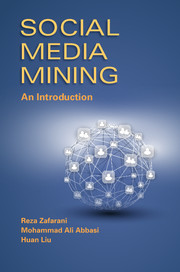Research Summary

My research interests are in (I) data science (data mining and machine learning), especially on large-scale data; (II) networks and graphs, especially theoretical research, and (III) analyzing online human behavior.
I am big fan of multidisciplinary research and as such I have a significant interest in mining social media as it provides me with the opportunity to pursue all my research interests under one unified ecosystem. I have championed the opportunities in such exciting interdisciplinary studies in my textbook on Social Media Mining: An Introduction; Cambridge University Press, check it out, it's free!
When conducting such interdisciplinary research, a common pattern in my studies is to collect and analyze large scale data to glean actionable patterns. When studying online human behavior, I often employ theories from social sciences, psychology, or anthropology, in addition to developing and using advanced mathematical, statistical, and machine learning machinery to prove the validity of such patterns. My research is supported by an NSF CAREER award.
For a sample of my work see our recent Tutorials:
- SDM 2022 - Noise Enhancement: Techniques and Applications (Slides);
- WWW 2022 - Interpretable Network Representations (Slides);
- WSDM'19/KDD'19 Tutorials: Fake News: Fundamental Theories, Detection Strategies and Challenges;
- or older ICDM Tutorial: Social Media Mining: Fundamental Issues and Challenges
Research Interests
- Data Science (Data Mining and Machine Learning)
- Social Media Mining
- Networks/Graph Mining
- Big Data Analytics
- Social Network Analysis
- Social Computing
- Analzying Online Human behavior
Research Directions
-

Traditionally, a network is represented by an adjacency matrix, which captures the nodes connected in the network. Adjacency matrices can be massive even for sparse large graphs, are not interpretable (e.g., not directly capturing complex relationships such as paths or cuts), and are hard to visualize, appearing as ``hairballs"; dense tangled structures of nodes and edges often carrying no insights. To address these challenges, we have recently developed new network representations that are (I) easy-to-visualize and (II) interpretable (i.e., structurally-informative. See these examples (Spectral Zoo, Spectral Paths and Network Shapes) and their applications in network authentication.
-

A summary of fake news research can be obtained through our survey. Our work includes research on detecting fake news using content or link (network) information and ways to detect fake news early. We have also recently worked on introducing the first techniques to assess the intent of fake news spreaders: see this paper. For more information see our KDD and WSDM Tutorials on the topic here.
-

To mine across social media sites, we particularly focus on two specific problems. First, how does user behavior vary across sites (e.g., difference between LinkedIn Friends and Facebook Friends). In addition to designing new techniques, we investigate means to scale and adapt traditional models that analyze user behavior for a single site to multiple sites. For recent results on this research question, see my papers in Information Fusion'16 and ICWSM'14 and this book chapter. Second, I study user behaviors that are only observed across sites. An example includes our study on user migrations across sites.
-

-

My research has investigated means to realistically analyze human behavior online by focusing on ways to exploit information redundancies generated by user behavior. The methodology has been used to identify sarcasm on Twitter, to identify users across sites, among other behaviors. For more on the topic see this article, this chapter, or our recent workshop on the topic. As a by-product, my research on human behavior modeling has had implication in information verification, privacy and security.
-

In data mining terms, ground truth is rarely available online. I recently started to investigate this problem and identified some ways to tackle the problem. For a succinct review of the topic see my recent Communciations of the ACM (CACM) paper on this issue.
-

I have looked at how to utilize minimum information to identify users, detect malicious users, or to recommend friends on social media sites with high accuracy. As these methods utilize only minimum information, they scale easily to millions of users. Recently, I have been investigating theoretical limits of using minimum information.
-

I have recently investigated the balance between privacy and mining user-generated content by connecting ideas from complexity theory, specifically Kolmogrov complexity. See this paper for some (very!) preliminary results.
-

-
My research has focused on (1) online means to map areas impacted by natural disasters in real-time [ICDM'15], (2) identifying relevant users that provide most useful information in case of crises [HT 2014], and (3) systematic approaches to crowdsource user-generated content in case of disasters [CMOT'12].